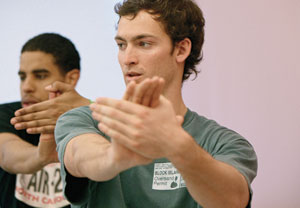
features |
1 > |
 Engaging spirits, minds, and bodies - The Mindfulness Project
Engaging spirits, minds, and bodies - The Mindfulness Project
by Rhea Hirshman • Photos by Bob Handelman
Robert Greene remembers the first time he walked into a martial arts school as a student—an experience that produced, he says “a mixture of excitement and dread.” Now an iaido instructor with Trinity’s Mindfulness Project, Greene—whose day job at Trinity is as a computing resource specialist in the Office of Admissions— works to create an inviting atmosphere while remaining true to the framework of a traditional martial arts class (Iaido is a Japanese way of mental presence and immediate reaction, exploring the peaceful art of drawing the katana sword.) “To do that,” he says, “I get the students engaged and moving; every second they stand listening to me talk is a second that they’re not fully learning.”
“Engaged and moving” could be the mantra for the Mindfulness Project itself. The interdisciplinary program, open to all students, is both a disciplined academic endeavor and an intense collaboration among students, faculty, chaplains, and staff to draw members of the Trinity community into practices and traditions that foster personal and communal well-being.
The program, which first ran as a full-semester course last fall, came together over several semesters and innumerable conversations. Spearheaded by a diverse group of faculty and staff, it is administered under the auspices of the office of the chaplain, the Reverend Allison Read. Read recalls “crashing student lunch tables” when she first arrived on campus in January of 2008 to find out what students wanted and needed from the college chaplain. At the same time, she was meeting faculty and staff in a variety of disciplines who were interested in the study of Asian, contemplative, and spiritual traditions, as well as contemporary thinking about wellness.
For example, Sheila Fisher, associate academic dean and professor of English, had been talking with Irene Papoulis, principal lecturer in the Allan K. Smith Center for Writing and Rhetoric, about Papoulis’ experience at the Center for Mindfulness in Society in Northampton, Massachusetts, and Fisher’s time at Kripalu, the renowned yoga center in the Berkshires. “We were thinking,” Fisher says, “that it would be really good for Trinity to bring some of that work here.” Katherine Power, associate professor of theater and dance and chair of the department, who is herself an avid practitioner, had been teaching lunchtime t’ai chi classes for staff and students. Professor of Religion and International Studies Ellison Findly, whose academic specialty is Asian religions, was engaged in her own practice of Buddhism, and Brownell Professor of Philosophy emeritus Richard Lee was a longtime practitioner of both t’ai chi and qigong. At the same time, Randy Lee ’66, director of the Counseling Center, along with Jaimie Burns, the center’s assistant director, were initiating a successful Transcendental Meditation program on campus.
While members of the faculty and staff had offered lectures, workshops, and short courses in these and related disciplines, Read says, “When the twelve or so of us gathered to learn about each other’s work, we began to articulate a shared sense that our work belonged together.” What they had in common, Read says, was “mindfulness above all else.” Over the course of three years, the Mindfulness Project offered classes and programs that drew on the disciplines of religion, philosophy, the performing arts, and Asian studies. These offerings focused on the integration of mind, body, and spirit, and on cultivating attention to interdependence in a pluralistic, multicultural, global community. What this group of faculty and staff members developed found an enthusiastic response, and the half-credit, semester-long Mindfulness Project Course offered in the fall of 2011 filled immediately when offered again this spring.
Each student enrolled in the Mindfulness Project chooses 10 weeks of studio practice from among iaido, t’ai chi, yoga, karate, or Zen meditation. Academic requirements include writing workshops, lectures with assigned readings, a written journal, and a final paper. Read notes that an emphasis on academic rigor was central to the development of the program. “As a practitioner seeking to draw students into understanding religious life, I wanted to see them engaged in scholarship about, as well as the practice of, these traditions.” “At the same time,” says Findly, “we were thinking about how to help students develop skills they need—attentiveness, concentration, openness, appreciation—but that are not usually offered in an academic setting.”
|
| 1 > |
